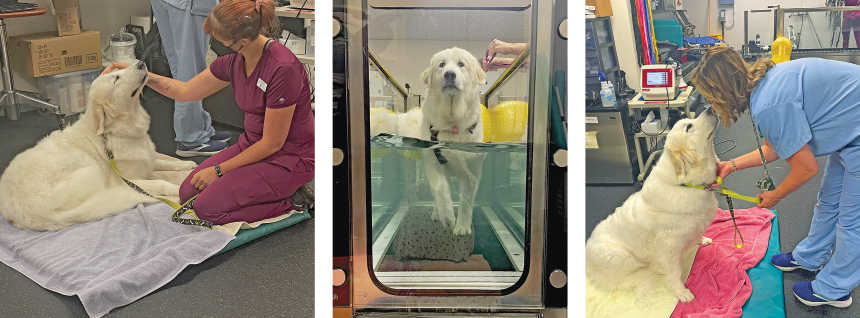

By Katheryn Kutil and Kelsie Donaldson
As protectors of animal health, veterinary professionals are tasked with making tough decisions and providing the best possible care to their patients and clients. Even in unthinkable situations, these Spartans give animals who appear to be on death’s door not only a fighting chance at survival but a continuation of life. Here are three cases where MSU clinicians made the seemingly impossible, possible.

In the afternoon of May 24, 2022, the Emergency and Critical Care Medicine Service (ECCM) at MSU was presented with King, a young Husky who had been shot in the abdomen and found collapsed in a drainage ditch. On presentation, he had no palpable or measurable blood pressure, was unresponsive, and had a temperature too low to read. He was hemorrhaging and his life was on the line. “From the moment he hit the table, everyone pitched in to give King the best chance at a positive outcome,” says Dr. Matt Beal.
When King first arrived, his team hit the ground running. They worked to get vascular access for resuscitation, got monitors going, set up fluids, prepped necessary medications, and advocated for pain meds and antibiotics. After a quick CT scan, King was rushed into emergency surgery, where the MSU Soft Tissue Surgery team, led by Dr. Maureen Spinner, repaired the punctures in King’s small intestine, flushed out his abdomen, and established drainage. A life-saving surgery, this fast-acting treatment kept King’s infection from spreading and potentially progressing to septic shock, an often-fatal condition.

King came out of anesthesia and was eventually taken off pressors, the medication that treated his critically low blood pressure. The team spent the evening sorting out his various conditions and setting him up for the days ahead. Busy days and weeks would follow the first long, long night in ECCM, not only for King but also for the team who fought around the clock to keep him alive.
“We could not be more grateful for the team who worked on King and took care of him,” says King’s owner. “No words can come close to describing how we feel about this team. Because of them, he’s going to make it. Our boy is going to make it!”
King spent three weeks in the Hospital. He underwent three surgeries, countless procedures, and a near-death experience. Today, he’s back home with his owners.

Equine dystocia, or difficulty birthing a foal, is not uncommon, but always urgent. After Rouby, an 18-year-old Oldenburg mare, was in labor for more than three hours, and two weeks late on delivery, her owner Valerie knew quick action was needed to save her beloved mare and her unborn foal.
When Valerie brought Rouby to MSU, the mare was alert but in distress. Her care team performed an abdominal ultrasound to check on her foal; there was no evidence of a fetal heartbeat, nor was the foal responding to stimuli, and the foal was in a very precarious position within Rouby’s womb, explaining the trouble with delivery.
“Since there wasn’t a detectable fetal heartbeat, a controlled vaginal delivery under general anesthesia was recommended and elected,” says Dr. Ashley VanderBroek, clinician for the MSU Large Animal Clinic.
After more than five hours of labor, Rouby delivered a beautiful, living colt. “Because Rouby had been in labor for more than five hours by the time that the foal was delivered, we were utterly shocked that the foal was alive, and even more impressed by how well he did post-delivery. Despite having all the odds against him, this colt was one of the healthiest foals we’ve seen this year,” says VanderBroek.
A more than five-hour-long labor took a toll on Rouby, and despite having birthed a strong, healthy colt, she wasn’t doing well. Even with supportive care, Rouby’s condition deteriorated quickly, and diagnostic tests showed that Rouby was suffering from septic peritonitis, an inflammatory and often-fatal condition. Due to her acute and severe clinical decline and a grave prognosis, a humane euthanasia was elected.
“Rouby was my favorite mare of all time. She was the absolute sweetest girl,” remembers Valerie. “I’m just so thankful that the foal got to nurse from her before she passed. That way, she knew what she had done.”
The foal, given the name Lazarus, remained well and healthy. As MSU’s equine team monitored him closely, Valerie began to search for a nurse mare. Within a few days, a mare named Pearl, owned by Dinah Strunk and Heidi Knight, was put in the stall next to Lazarus. The window between stalls was left open for a slow introduction, and the following day, the pair were united under supervision. The introduction went well, and Pearl allowed him to nurse. At the time of his discharge, the young colt was healthy and active with normal foal behavior—much in part due to Pearl and her gracious owners.
Lazarus spent eight days at MSU. More than two months following the foal’s birth, Lazarus and Pearl are reported to be doing well at the barn where they currently live together.

Sadie, a Great Pyrenees, became a Spartan at a young age: at just 10 months old, Sadie was presented to the MSU Rehabilitation Service due to the concern of right hind limb lameness. One of her littermates bit her right hind leg when she was four weeks old, an injury that led to severe bacterial infection at the tarsus (ankle joint) and tibia (the shin) of her leg. Sadie was treated with antibiotics until she was three months old.
“The infection got quite severe,” says Sadie’s owner. “But she never gave up.” Though the infection was gone, Sadie was left with what looked like a peg leg—or a calcified tarsal joint. This caused the persistent lameness and would require joint fusion surgery or amputation to correct.
However, Sadie’s owner wasn’t fond of either of those options. She wanted to pursue rehabilitation before she put Sadie through potentially more painful and invasive treatment options. So, for more than three years, she’s been making the hour-long trek to MSU so Sadie can receive rehabilitation therapy. “I ended up here because MSU is the best,” adds Sadie’s owner.
During her bi-weekly sessions, Sadie receives therapeutic laser and massage and completes 30 minutes of hydrotherapy on MSU’s underwater treadmill. On top of her sessions at MSU, Sadie also receives at-home therapy sessions. “Sadie’s owner is amazing at taking care of her at home,” says Stephanie Kiszka, veterinary nurse for the MSU Rehabilitation Service. “She performs daily home exercises to ensure utilization of all her muscles and gives her daily massages to keep her muscles in good condition.”
Now four years old, Sadie is a healthy weight and has lots of fun playing with her fur brother. “She runs around, plays, body slams her larger brother,” says Sadie’s owner. “She’s just a happy dog and her whole mentality is great. She’s so cooperative and smart. She works hard when she comes to MSU and when we do our at-home exercises.”
Her owner adds, “The MSU Rehabilitation team is so awesome with her. I just love them. And so does Sadie.” 
After more than three years and 100 visits as an MSU Rehabilitation Service patient, Sadie is infection and pain free.

